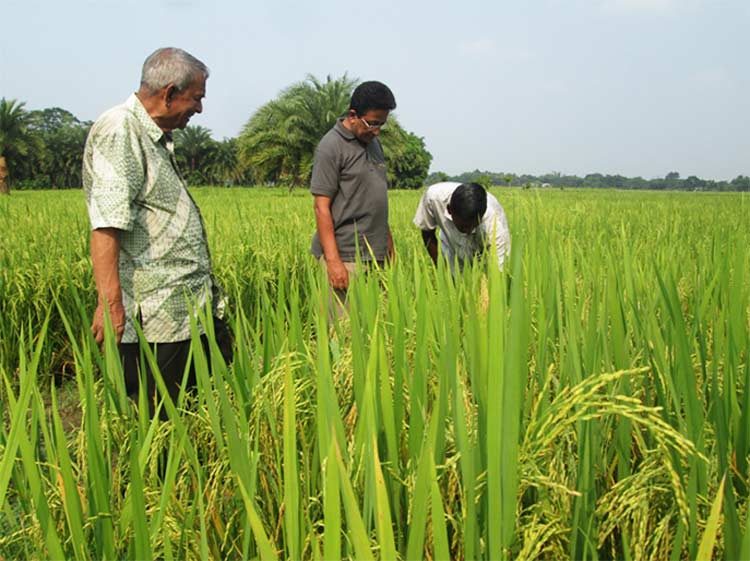Successful mixed cropping of rice with Jute

Krishnapur is a village on the bank of the river Khalishadanga. It is in Nagor Union, Upazila: Borigram, District: Natore. In the dim and distant past this village was proudly rich in genetic resources. However, the farmers were almost exhausted of their precious possession of land races in the wave of pursuing modern agricultural practices. Recently they were oriented to Nayakrishi Andolon (new agricultural movement).They are now striving to regain their lost seed and genetic resources. The farmers in Krishnapur village have been practicing Nayakrishi for last ten years. The genial flow of water in the Khalishadanga river and mild siltation through seasonal flooding have been continuously enriching the land and the biological diversity in the vicinity.
The Nayakrishi farmers have been rejuvenating the land races with immediate focus on aus rice, aman rice and jute. The aus rice varieties included Kalabakri, Kalamanik, Shoni, Shankopoti,Voira, Mulkeaus, Kharajamri,Shaita,Vaturi,and Jessori . Patjag, Moynagiri, Digha, Kalojira, Laldhepa, Sadadhepa, Patishail, are the major varieties of aman rice. Deshi Jute varieties are grown in medium and low lands in early sowing while tossa jute varieties are preferred for high lands in late sowing situation.
Relay cropping of rice with jute is a significant success of the Nayakrishi farmers of Krishnapur village. The remarkable success of mixed relay cropping of rice with jute of the Nayakrishi farmers has been a bright example and encouraging the other farmers in this practice. The farmers sow jute seed in the field in second fortnight of March. Jute plants grow luxuriantly with increasing temperature, day length, relative humidity and rain fall. Rice is sown broadcast in jute field about 15 days before harvest in mid August. Rice seedlings grow and emerge with full vigor after the harvest of jute plants.
Shukchand, a Nayakrishi farmer mentioned, “soil fertility improves after jute cultivation. Jute plants have tap roots. The roots break the plough pan and takes up nutrients from the deeper layer of soil. The plants drop leaves during growth, development and add organic matter in the soil. Consequently soil becomes rich and good for growth of any crop.”
According to the practical experience of the farmers it is known that the cost of production of rice as a relay crop with jute is very low. There is only need of thinning of rice seedlings in case there is excess of plants. Moreover, these seedlings can be transplanted in other fields. Rice is harvested in end November to early December.
Nasima Begum, Shafiqure and Shukchand shared their experience of mixed cropping of rice with jute production. The cost of jute production per bigha (0.13ha) is BDT 6300 (BDT47,15.4/ha). The yield of jute was 10 mds/bigha (2.79 t/ha) and the gross return per bigha was BDT 25,000(BDT187,121/ hectare). The net return from jute production per bigha was BDT 18,700 (BDT1,39,966/hectare).
Farmer Shafiqul has cultivated relay mixed crop of rice with jute on 8.25 decimals of land this year. He had sown broadcast 3 kg paddy in jute field 15 days before jute harvest. The UBINIG visiting research team observed 4/5 feet tall `Jessori, variety of rice in the field. These plants had long panicles.
Shafiqul appeared very happy at the performance of his crop. He happly informed that he had no expense for land cultivation.
Only he spent BDT 250 for weeding of rice field. May be he will need BDT 250 more for paddy harvest. He expects four maunds of rice from this land (4.47t/ha).
He will get 8 mds of straw worth of BDT 1400 (BDT 41,915/ha). Net return from aus rice will be BDT 3700 (BDT 1,10,775/ha).

Nasima Begum has grown BR 24 variety of rice on 16.5 decimals of land. She had sown seeds of tossa jute in late March. She harvested jute in early August. She spent BDT 3450 for jute production. She earned BDT 12,500 by selling jute (BDT 187,121/ha). She earned net return from jute production BDT 1, 35,475/ha.
BR 24 rice was transplanted in that field after the harvest of jute. She spent BDT 2,300 for seed bed, transplanting, plowing and weeding. Rice harvest will account BDT 500 for labor. Nasima Begum is expecting 7 maunds of rice and the gross return of BDT4900 by selling rice. She will earn BDT 1500 by selling straw. She will earn net return of BDT 3600 (BDT 53,890/ha).

Mixed cropping of rice with jute has been contributing to increased economic return to the farmers along with improving the soil fertility. The farmers in the locality have become encouraged in mixed cropping of rice with jute. Consequently there is increasing acreage of both rice and jute. Nayakrishi farmers desire the extension of jute and rice cultivation in the interest of food sovereignty and cash income for the community.